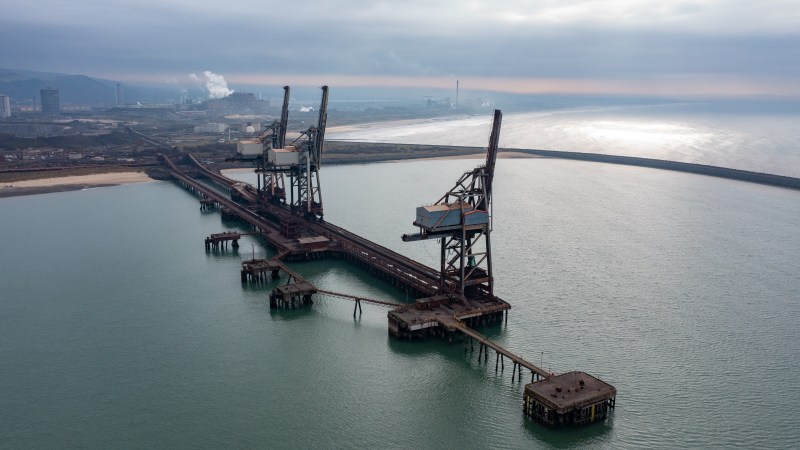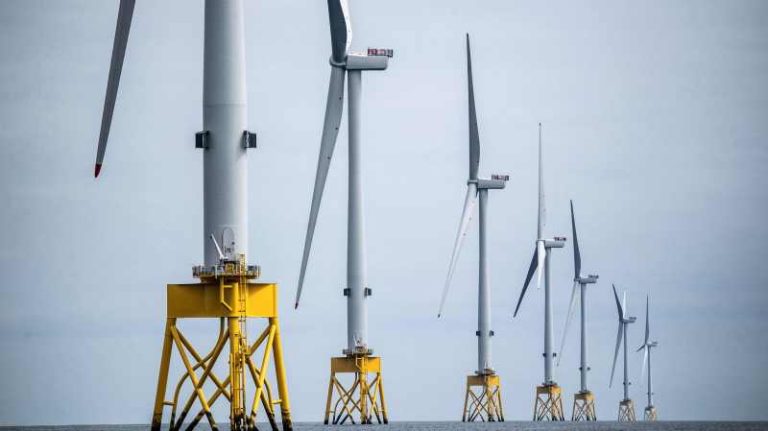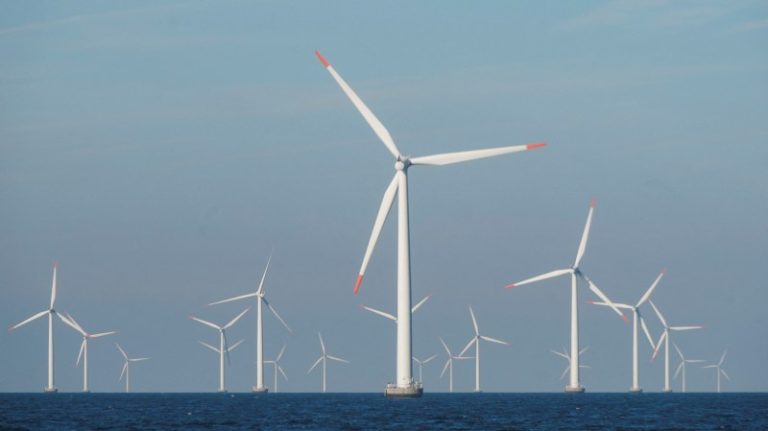How floating offshore wind turbines can re-energise Port Talbot
On the day The Times visits Port Talbot, a 40mph gale is blowing, whipping up white horses in the bay. If this were the North Sea, offshore wind turbines would be spinning furiously. Here, however, because the nearby waters of the Celtic Sea are too deep to attach turbines to the seabed, the energy is going unused.
Plans are afoot to capture wind energy around Port Talbot in a different way. Rather than building them into the seabed, wind farm developers are planning to install hundreds of turbines on floating platforms, attaching them to the bottom only with anchors.
It might conjure images of large, spindly turbines toppling into the waves but it’s a proven concept. Off Peterhead in Scotland, six floating turbines have been spinning away since 2017. That wind farm — Hywind Scotland — is expected to become the first of many, as developers seek to exploit the 80 per cent of wind resources worldwide that lie outside shallow waters.
Although Hywind Scotland was a world first for Britain, the turbines were assembled in Norway before being towed across the North Sea, an approach common to the country’s implementation of offshore wind.
The UK has become a world leader in offshore wind, attracting foreign companies to put up turbines around its coasts, and now has more offshore turbines than any country except China.
However, the nation has had less success in fostering a domestic wind industry. Only about half the money energy companies have spent on building wind farms in British waters has gone to companies operating in the UK. Many of the components and installation ships have come from Denmark, Germany and Spain.
At Port Talbot, Associated British Ports (ABP), which owns and operates 21 ports in the UK, wants to change that. The company is investing £500 million to turn this port into a “manufacturing hub” of floating offshore wind in the Celtic Sea. In so doing, it hopes to bring a new, green industry to a town beset by the decline of an old polluting one.

Port Talbot was the name given to new docks in 1837 after the local landowner and MP Christopher Rice Mansel Talbot, but came to describe the wider community as its industrial importance grew.
Next to the harbour is Tata’s steelworks, the UK’s largest producer not only of steel but also of carbon emissions. The steelworks, one of the biggest in the world, has been under threat of closure since the 1980s.
Huge mounds of coking coal are piled up around the site, ready to be shovelled into its last two remaining blast furnaces that will soon be closed, creating up to 2,800 redundancies. Workers at the plant, which has a workforce of about 4,000, recently backed strike action over the closures.
Lumen Energy & Environment, a consultancy firm, has estimated that the launch of floating offshore wind in the Celtic Sea could create 5,300 jobs. The Crown Estate is tendering bids for the development of 4.5 gigawatts (GW) of floating wind in the Celtic Sea, and the government plans to develop a further 12GW.
Combined, that’s more offshore wind than has so far been deployed in all the UK’s waters. By the early 2030s, turbines could be erected here at the rate of three a week, and Port Talbot, with its deep harbour, could be best placed to make that happen.
“As offshore wind moves from fixed bottom to floating, there’s an opportunity for the UK to grab more of the economic activity that we didn’t grasp previously,” Andy Reay, ABP’s head of offshore wind, says. “We’ve historically got away with relatively modest investments in ports to deliver fixed-bottom offshore wind, but floating offshore wind has very different port infrastructure requirements.”
Whereas fixed-bottom turbines are pieced together out at sea, it’s much harder to build a turbine atop a platform, so ABP envisages that most floating turbines will be fully assembled in port and then tugged out to sea, giving manufacturers reason to base themselves nearby.
That assembly process will require a lot of space. Quays will have to be broadened to support cranes that will build the turbines’ football pitch-sized platforms. Space must also be made for laying down the turbines’ fibreglass blades, which are as tall as the Elizabeth Tower. ABP intends to apply for planning permission for all this by June next year and to have finished upgrading the port by the end of the decade.
BW Ideol, a French company that makes concrete platforms for wind turbines, and Swansea-based Marine Power Systems (MPS), which makes platforms out of steel, are competing to supply the project.
Paul de la Guérivière, chief executive of BW Ideol, believes his company has the advantage because “there is absolutely no way to be cost-competitive manufacturing steel foundations in Europe. You would have to manufacture them in Asia then tow the structure to Europe.”
Anthony Glick, MPS business development manager, agrees that “there is an issue with steel plate, we don’t produce enough steel plate in the UK so we may have to buy that from somewhere else. But in terms of the welding and fabrication [of the steel foundations] the UK can be very well placed.”
He says that MPS is working with Tata Steel to develop a foundation made from strip steel, which can be produced in the steelworks’ new electric arc furnaces, rather than the plate steel made in the soon-to-be closed blast furnaces. “So hopefully our platforms can be made from local steel.”
He adds: “It’s disappointing that so many people at the steelworks will sadly lose their jobs, but there’s still going to be steel produced in south Wales, and that’s a great positive. In the future, Tata hopes to be producing clean plate steel using hydrogen, rather than coal. How great would that be, if we can make all our foundations from that plate steel, rather than having to ship it in from around the world as we may have to in some cases?”
Glick says that ports around Europe are competing to attract wind turbine manufacturers to their premises. “There are lots of ports in Europe that are having huge amounts of money spent on them to do exactly what Port Talbot wants to do. Lots of manufacturers are already based in Bilbao, for instance, and it’s feasible that either components or entire wind turbines could be produced there and then towed to the seas around Wales. We don’t want that. We want everything produced here.”
Last month, Sir Keir Starmer pledged that Labour would deliver “the biggest investment in our ports in a generation”, spending £1.8 billion to make them ready for floating offshore wind. Glick says this money would be best spent “encouraging overseas businesses to locate in Port Talbot to build a supply chain here. If that’s what that money is used for it would be a step change.
He says: “There is no reason why this could not be a significant manufacturing hub. Right now, there are lots of engineering graduates from Swansea who leave the area because there aren’t the jobs. This gives us an opportunity to retain those people in the Swansea and Port Talbot area, and it will be a well-paid industry.”






